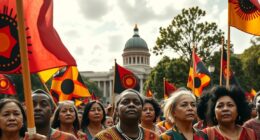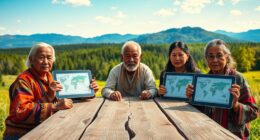I am intrigued by the number of individuals who are curious about their heritage, especially when it involves their indigenous roots. Have you ever wondered about your familial connection to a specific Native American tribe?
Finding out your indigenous lineage can be a meaningful journey that offers insight into your family's history and cultural background. There are several methods and resources available to help unravel this mystery, and in the following paragraphs, we'll explore some effective ways to navigate this exploration and potentially discover your indigenous tribe.
Key Takeaways
- Approach research methodically and open-mindedly, utilizing historical records and family narratives
- Utilize DNA testing services in conjunction with other research methods to gain insight into ancestral origins and connections
- Engage with Indigenous organizations, attend cultural events, and listen to oral history and storytelling traditions to deepen understanding of tribal heritage
- Understand the process of tribal recognition and the concept of affiliation, recognizing that affiliation involves individual connections influenced by familial ties, cultural involvement, and personal identification.
Researching Your Family History
When tracing your family history, it's essential to approach the research with a methodical and open-minded mindset, as it requires thorough investigation and analysis of historical records and family narratives.
Tracing ancestors involves delving into a wide array of sources, such as census records, birth and death certificates, immigration documents, and land deeds. These documents provide vital clues to unraveling the past and identifying the lineage of your indigenous tribe.
Moreover, oral history gathering is a crucial aspect of this process. Engaging with older family members or community elders can unveil treasured stories, customs, and traditions that have been passed down through generations. These narratives often hold valuable information about ancestral origins, migrations, and cultural practices.
It's imperative to approach oral history with respect and an open heart, valuing the wisdom and experiences shared by your relatives. By combining meticulous research with the rich tapestry of oral traditions, one can construct a comprehensive understanding of their family's heritage and potentially identify the indigenous tribe to which they belong.
Utilizing DNA Testing Services

In our quest to uncover our indigenous tribe, one invaluable avenue for exploration is the utilization of DNA testing services, which can provide insight into our ancestral origins and connections. DNA testing can help identify specific genetic markers that are associated with particular indigenous tribes, offering a glimpse into our heritage that may not be easily accessible through traditional genealogical research.
| DNA Testing Service | Test Features | Cost |
|---|---|---|
| 23andMe | Ancestry composition, haplogroup analysis, DNA relative matching | $99 – $199 |
| AncestryDNA | Ethnicity estimate, DNA matches, migration patterns | $99 |
| FamilyTreeDNA | Y-DNA and mtDNA testing, autosomal DNA testing, ancient origins | $79 – $199 |
When considering DNA testing services, it's important to research the specific features offered by each provider and the cost associated with their tests. Some services may focus more on ancestry composition and ethnicity estimates, while others may delve deeper into haplogroup analysis and ancient origins. It's crucial to choose a reputable company that prioritizes privacy and data security. Additionally, understanding the limitations of DNA testing, such as its inability to provide comprehensive tribal affiliations, is essential. DNA testing, when used in conjunction with other forms of research, can be a powerful tool in our pursuit of discovering our indigenous roots.
Accessing Genealogical Records
We can access genealogical records through various sources, including online databases, government archives, and local historical societies.
Ancestry research often begins with online databases such as Ancestry.com, FamilySearch, and MyHeritage, which offer extensive collections of historical documents, including birth and death records, census data, immigration records, and military documents. These platforms enable users to trace their family lineage and identify potential Indigenous ancestry.
Additionally, government archives play a crucial role in preserving historical documents such as land records, tribal enrollment records, and Indian census rolls, which are valuable resources for individuals seeking to connect with their Indigenous heritage.
Local historical societies also provide access to unique collections of historical documents, personal papers, and oral histories that can shed light on Indigenous ancestry within specific regions.
Reaching Out to Indigenous Organizations

How can individuals proactively engage with Indigenous organizations to explore and connect with their tribal heritage? Reaching out to Indigenous organizations is a valuable way to tap into a wealth of knowledge, resources, and community support.
One effective approach is to attend cultural events and actively participate in community involvement initiatives organized by Indigenous groups. These events provide an opportunity to engage with tribal members, learn about traditional customs, and gain insight into the unique practices and beliefs of different Indigenous tribes.
Furthermore, engaging with Indigenous organizations can also involve seeking out opportunities to listen to oral history and storytelling traditions. Many Indigenous communities have a rich tradition of passing down knowledge through oral narratives, which can offer valuable insights into familial and community histories.
Actively seeking out and respectfully engaging with these traditions can provide individuals with a deeper understanding of their tribal heritage and foster connections with Indigenous communities.
Understanding Tribal Recognition and Affiliation
Understanding Tribal Recognition and Affiliation requires a comprehensive examination of the legal, historical, and cultural factors contributing to the complex landscape of Indigenous identity.
Recognition is a crucial aspect for Indigenous individuals and communities in establishing their belonging to a specific tribe. It's essential to understand that tribal recognition is determined by legal procedures, often involving federal acknowledgment processes, and varies across different countries. In the United States, for example, tribes may seek federal recognition through the Office of Federal Acknowledgment. This recognition is based on specific criteria, including evidence of continuous political authority and distinct cultural and historical identity.
Understanding culture and history plays a significant role in the recognition process, as it involves demonstrating the tribe's unique traditions, language, social structure, and historical continuity. Additionally, recognizing and respecting tribal sovereignty is paramount, as it acknowledges the inherent rights of Indigenous tribes to govern themselves and maintain their cultural practices.
Affiliation, on the other hand, delves into individual connections to tribes, often influenced by familial ties, cultural involvement, and personal identification.
Understanding tribal recognition and affiliation is a multifaceted endeavor that requires a deep appreciation of legal, historical, and cultural dimensions.
Frequently Asked Questions
Are There Specific Cultural Practices or Traditions That Can Help Me Identify Which Indigenous Tribe I May Be From?
Specific cultural practices and traditions, along with DNA testing and ancestral records, can help identify an indigenous tribe. These may include language, ceremonial rituals, art, and traditional clothing.
DNA testing can provide clues about ancestral origins, while ancestral records and oral histories can offer valuable insights.
It's important to approach this process with respect and sensitivity, recognizing the diversity of indigenous cultures and their unique practices.
What Are Some Common Misconceptions About Indigenous Tribal Identity That I Should Be Aware of When Researching My Heritage?
Common misconceptions about indigenous tribal identity include assuming that all tribes have the same cultural practices. It's important to be aware of the diversity within indigenous communities and not to generalize.
When researching heritage, understanding that cultural practices can vary widely and that there isn't a one-size-fits-all approach is crucial. By recognizing and respecting the uniqueness of each tribe's traditions, we can approach our heritage research with a more open and informed perspective.
How Can I Connect With Other Individuals Who Are Also Trying to Discover Their Indigenous Tribal Heritage?
Connecting with community is crucial in discovering indigenous tribal heritage. Sharing stories and experiences with others who are navigating the same journey can provide valuable insights.
DNA testing and historical records can also offer clues. By collaborating with others and pooling our resources, we can collectively piece together our ancestral histories.
This process not only fosters a sense of belonging but also helps us reclaim and honor our indigenous roots.
Are There Any Specific Government or Legal Requirements for Proving Indigenous Tribal Affiliation?
Legal documentation and genealogical research are essential for proving indigenous tribal affiliation. Tribal enrollment and government recognition may require specific documentation, varying by tribe and region.
According to the U.S. Census Bureau, over 570 recognized tribes exist in the United States. Understanding the unique requirements of each tribe is crucial.
Engaging with tribal authorities and legal experts can provide valuable guidance in navigating these processes.
What Are Some Challenges or Obstacles I May Encounter When Trying to Identify My Indigenous Tribe?
Challenges and obstacles in identifying indigenous tribe can include lack of records, displacement, and cultural assimilation.
Genealogical research and DNA testing may help, but these methods also have limitations, such as incomplete or inaccurate data.
Indigenous identity is complex and deeply rooted, requiring sensitivity and respect. Understanding diverse cultural perspectives is crucial in this process.
Conclusion
In conclusion, finding out what indigenous tribe we're from is like peeling back layers of a complex tapestry.
By researching our family history, utilizing DNA testing, accessing genealogical records, and reaching out to indigenous organizations, we can piece together the puzzle of our heritage.
It's a journey of discovery, like unraveling a tightly woven fabric, each thread revealing a part of our unique cultural identity.









